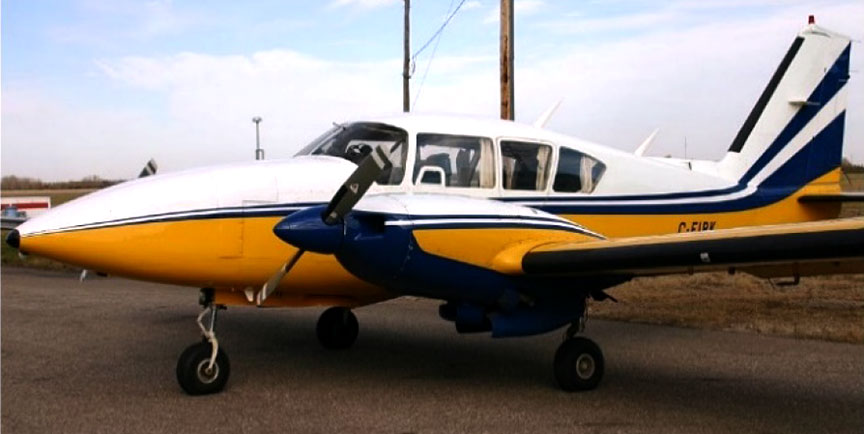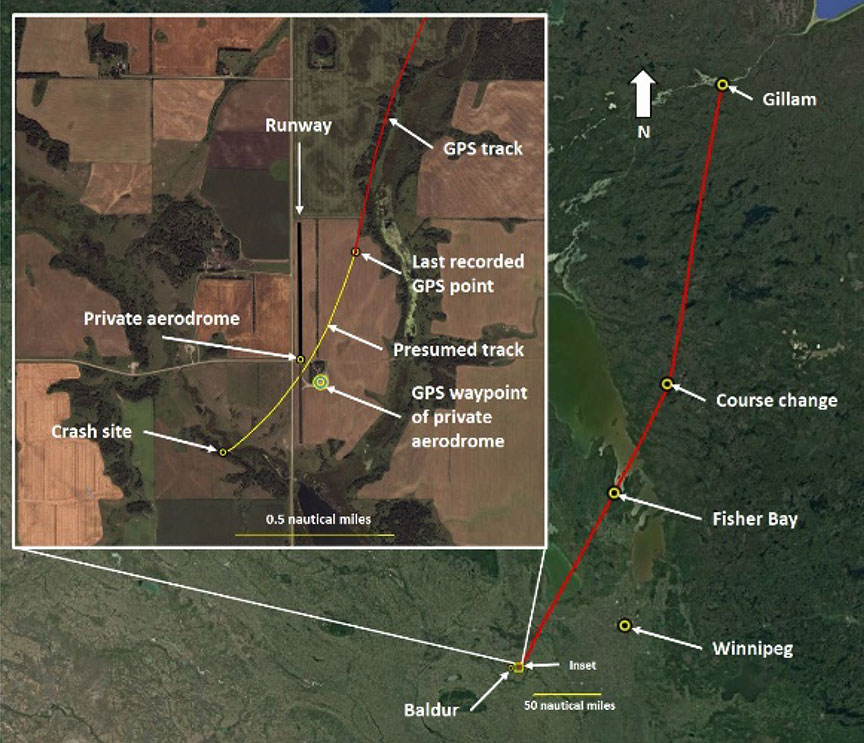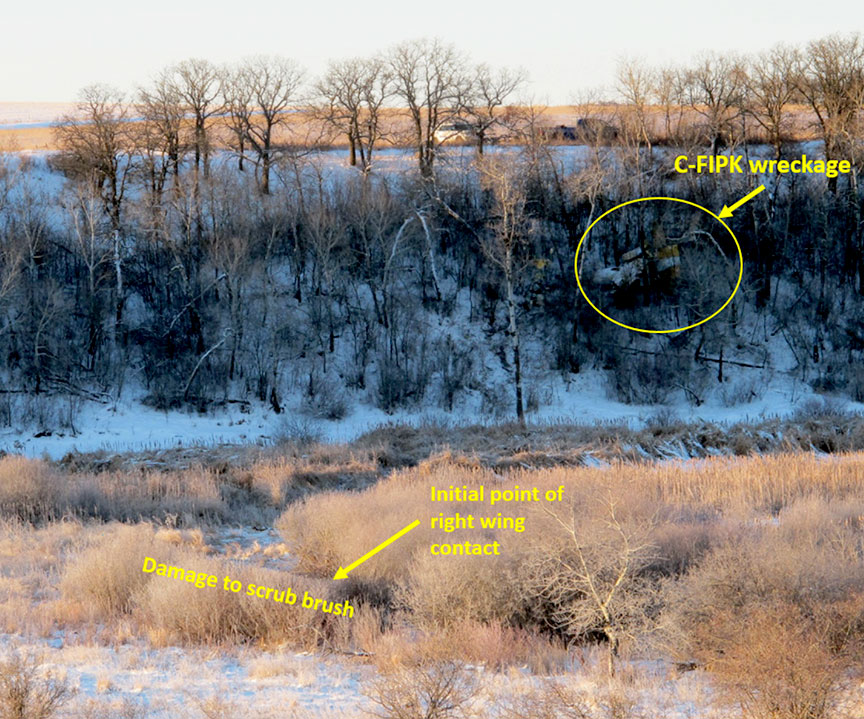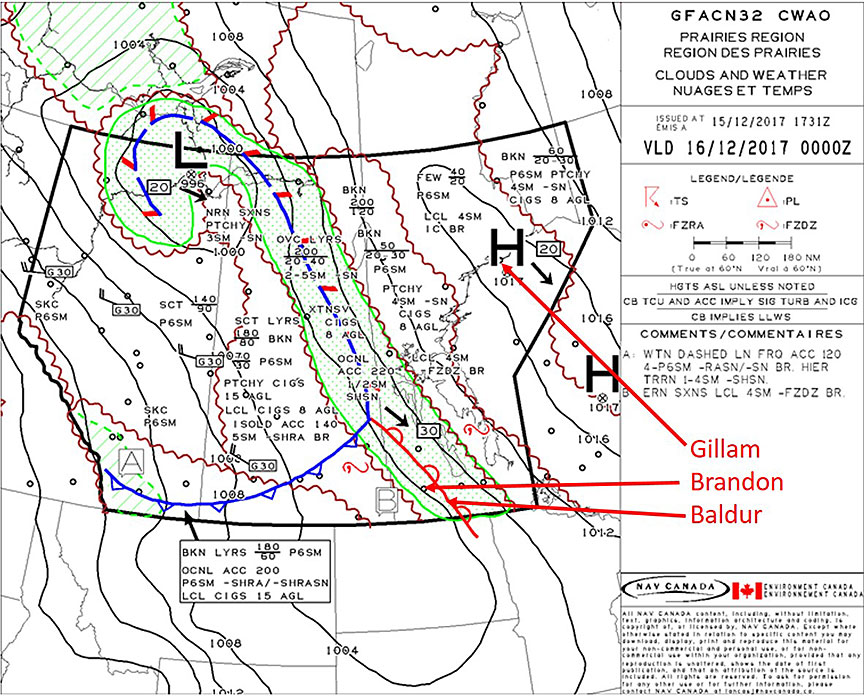Collision with terrain
Piper PA-23-250 Aztec, C-FIPK
Baldur, Manitoba, 5 nm E
The Transportation Safety Board of Canada (TSB) investigated this occurrence for the purpose of advancing transportation safety. It is not the function of the Board to assign fault or determine civil or criminal liability. This report is not created for use in the context of legal, disciplinary or other proceedings. See Ownership and use of content. Masculine pronouns and position titles may be used to signify all genders to comply with the Canadian Transportation Accident Investigation and Safety Board Act (S.C. 1989, c. 3).
History of the flight
On 15 December 2017, the privately registered Piper PA-23-250 Aztec (registration C-FIPK, serial number 27-8054059) (Figure 1) was conducting a visual flight rules flight from Gillam Airport (CYGX), Manitoba, to an unlighted private aerodrome located 5.25 nautical miles (nm) east of Baldur, Manitoba, with only the pilot on board (Figure 2).
On the day of the occurrence, the pilot had departed from the private aerodrome at approximately 1130Footnote 1 with a full fuel load. His plan was to fly to Dauphin (Lt. Col W.G. (Billy) Barker, VC) Airport (CYDN), Manitoba, and then continue on to CYGX before returning to the private aerodrome later that same day.
Shortly after arrival at CYGX, the pilot requested that the wing-tip fuel tanks be filled, taking on 160 L (42 U.S. gallons) of fuel. While the pilot was at CYGX, a family member texted the pilot to inform him that snow was causing poor visibility at the private aerodrome and that an increase in wind speed and gusts was expected at his estimated time of arrival. Consequently, the pilot decided to fly to Winnipeg/James Armstrong Richardson International Airport (CYWG), Manitoba, instead, which is located approximately 78 nm northeast of the private aerodrome and 51 nm closer to CYGX.
The aircraft departed CYGX at 1550 and climbed to 9000 feet above sea level (ASL) on a direct track to CYWG. At 1715, when the aircraft was approximately 174 nm from CYWG, the pilot altered course to a southwest heading that would take him directly to the private aerodrome.
At approximately 1745, the pilot received a text message from the same family member indicating that, before dark, the visibility at the private aerodrome had been about ¾ statute mile (sm) in snow. About half an hour later, the pilot made arrangements with the family member to make vehicle tracks on the runway and then place the vehicle at the north end of the private aerodrome with the headlights pointing to the south. Shortly thereafter, the pilot was informed that the wind was about 10 to 15 knots and that the tracks had been made on the runway. Snow was still falling and there were now about 3 inches of snow on the runway.
At 1834, the aircraft began to descend from its cruising altitude at a rate of approximately 1550 feet per minute. When it was roughly 0.87 nm northeast of the private aerodrome, the aircraft levelled off briefly at approximately 400 feet above ground level (AGL), before resuming the descent. The aircraft descended through 200 feet AGL immediately prior to crossing over the middle of the private aerodrome, on a southwest heading. As the aircraft passed overhead, the family member drove the vehicle to the north end of the runway, expecting that the pilot would circle to the north before returning to land. However, immediately after overflying the private aerodrome, the aircraft descended into a small valley following sloping terrain.
At 1838, in the hours of darkness,Footnote 2 the aircraft crashed on a frozen marsh in the bottom of the valley. The pilot received fatal injuries. There was no fire. The 406 MHz emergency locator transmitter (ELT) activated; however, the Cospas-Sarsat system did not detect a signal.
Search
When the aircraft had not arrived by 1900, a ground search by vehicle was initiated. The ground search proved unsuccessful and, at 2000, the Joint Rescue Coordination Centre (JRCC) in Trenton, Ontario, was notified of the overdue aircraft. The JRCC contacted the local Royal Canadian Mounted Police (RCMP) and tasked a Royal Canadian Air Force Lockheed C-130 Hercules aircraft to conduct a search, which began at approximately 2300. The Hercules aircraft detected a weak 406-MHz ELT transmission; however, it was not possible to home in on the signal. Owing to deteriorating weather conditions, the Hercules was forced to abandon the search at 0200 on 16 December 2017. The Hercules was able resume the search later that morning and again detected a weak 406 MHz ELT signal.
The JRCC contacted the local chapter of the Civil Air Search and Rescue Association (CASARA) at 0546 and a coordinated ground and air search was initiated. CASARA members detected a strong 121.5-MHz ELT signal east of Baldur. The crash site was discovered at 1500 on 16 December 2017, approximately 0.38 nm southwest of the private aerodrome.
Aircraft information
The Piper PA-23-250 Aztec is a twin-engine aircraft certified for day and night visual flight rules and instrument flight rules operations. A total of 177 U.S. gallons of fuel can be carried in 2 tanks in each wing and 2 wing-tip tanks. Each wing-tip tank functions as an extension of the respective outer wing tank. The aircraft was equipped with airframe and propeller de-icing equipment and a radar altimeter.
During the occurrence flight, the aircraft was lightly loaded with only the pilot and miscellaneous aircraft equipment on board.
The aircraft was certified, equipped and maintained in accordance with existing regulations and approved procedures. It had no known deficiencies and was being operated within its certified weight and centre-of-gravity limits.
Impact and wreckage information
The right wing contacted scrub brush roughly 8 feet from the marsh surface (Figure 3). Damage to the scrub brush indicates that the aircraft was in a 5° descent while banking approximately 23° to the right.
The right wing-tip and fuel tank were torn away on contact with the frozen marsh. The aircraft travelled across the marsh for about 300 feet before colliding with the steeply rising tree-covered terrain on the southwest side of the valley. The left outer wing-panel had broken away after contacting a tree, at a height of about 15 feet, and lay on the right side of the wreckage trail, near the side of the valley. The aircraft came to rest, inverted, halfway up the side of the valley, approximately 425 feet from the initial point of contact with the marsh surface. The aircraft was destroyed by impact forces.
Spilled fuel was evident along the wreckage trail at locations coincident with burst fuel tanks. Calculations indicate that the aircraft would have had approximately 45 minutes of fuel remaining. Both propellers exhibited damage consistent with substantial power being produced by the engines. The engine-driven dry vacuum-pump drive adapters were intact and the carbon rotors of both pumps were in good condition. There was no indication that the flying surfaces had accumulated any ice during the flight.
The right altimeter was intact and the barometric scale was set to 29.92 inches of mercury (in. Hg). No information could be obtained from the left altimeter. The radar-altimeter alerter setting was found set to 200 feet AGL.
The pilot had been seated in the left-hand seat. The seat had separated from the airframe attachment points. The pilot's seatbelt and shoulder harness had been fastened. The landing gear was down and locked and the flaps were up. The ELT remained secure in its mount with the antenna cable attached; however, the connection at the antenna was severed.
All of the aircraft's components were accounted for within the wreckage trail. Examination of the wreckage did not reveal any pre-existing mechanical conditions that could have contributed to the crash. A portable global positioning system (GPS) unit and a tablet computer were found at the wreckage site and sent to the TSB laboratory for data retrieval.
Weather
The weather at CYGX at the time of the aircraft's departure was reported as clear sky conditions, light winds, temperature of −26°C and an altimeter setting of 29.92 in. Hg. The forecast weather, available at the time of departure and based on the graphical area forecast, indicated that extensive ceilings of 800 AGL with visibility of 2 to 5 sm in light snow with occasional visibility of ½ sm were expected for the Baldur area (Figure 4).
The official aviation weather observation station that is located nearest to the destination private aerodrome and that was reporting at the time of the occurrence is at Brandon Municipal Airport (CYBR), Manitoba, which is located 52 sm northwest of the occurrence site. At 1802, the weather at CYBR was reported as visibility of 1½ sm in light snow and drifting snow, a vertical visibility of 700 feet, a temperature of −8°C, and an altimeter setting of 29.56 in. Hg.
Pilot
The pilot had held a commercial pilot licence since January 1981. He had obtained a multi-engine rating in June 2017 and held a valid Class 1 medical certificate. He did not hold an instrument flight rating. Records indicate that the pilot had accumulated more than 4000 hours of flying time.
The pilot had flown the occurrence aircraft occasionally beginning in October 2016, before purchasing it in December of that same year. Since October 2016, he had flown the aircraft for a total of 140 hours, 122 of which were as pilot-in-command. In the 30 days prior to the accident flight, the pilot had flown the aircraft for 32 hours.
Private aerodrome
The private aerodrome consists of a north/south, unlighted, gravel runway at an elevation of 1417 feet ASL that runs parallel to, and 160 feet to the east of, a provincial road. The area has little to no cultural lighting other than that produced by the buildings at the private aerodrome and some scattered farmyards. The Canadian Aviation Regulations prohibit aircraft from landing or taking off at night at an aerodrome that does not have the required lighting,Footnote 3 unless the flight is being carried out as part of a police operation or to save a human life.Footnote 4 There are a number of means by which the lighting requirements can be incorporated into a private aerodrome.Footnote 5 Lights, or a combination of lights and retroreflective markers, can be installed on the runway edges. The operator of an aerodrome may also display flare pots to provide temporary lighting for the landing or takeoff of aircraft.
A driveway connects the hangar area to the highway and divides the runway into a 2700-foot-long north section and a 1500-foot-long south section. The pilot operated C-FIPK from the 2700-foot-long section of the runway, north of the driveway.
Global positioning system unit data
The pilot routinely used a portable GPS unit that was secured in a clamp-style mount. The private aerodrome was identified in the GPS unit by a waypoint that was centred on the location of a hangar, roughly 500 feet east of the runway. There were no other waypoints denoting the actual location or orientation of the runway. The GPS unit was recording the track of the aircraft at regular intervals up to a point approximately 0.35 nm northeast of the private aerodrome. The projected track indicated that the aircraft would have crossed the private aerodrome near where the driveway intersected the runway.
Altimeter settings
To indicate the aircraft's actual altitude ASL, the altimeter's barometric scale must be adjusted to the altimeter setting for the region that the aircraft is operating in. A pressure change of 0.1 in. Hg results in a change in indicated altitude of about 100 feet.
The Environment and Climate Change Canada surface analysis indicated that the altimeter setting near Baldur was likely similar to CYBR, which was 29.56 in. Hg. Given the right altimeter's setting of 29.92 in. Hg, when the aircraft was near the private aerodrome, the aircraft's indicated altitude on that altimeter would have been approximately 360 feet higher than its actual altitude. However, due to the damage, it was not possible to determine the left altimeter's setting or the altitude indication that was being presented to the pilot.
This concludes the TSB's limited-scope investigation into this occurrence. The Board authorized the release of this investigation brief on . It was officially released on .



